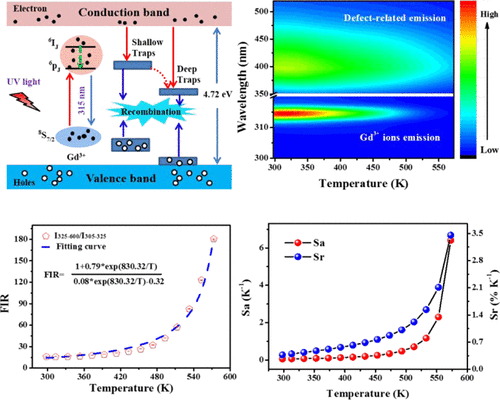当前位置:
X-MOL 学术
›
J. Phys. Chem. C
›
论文详情
Our official English website, www.x-mol.net, welcomes your
feedback! (Note: you will need to create a separate account there.)
Novel Optical Thermometry Strategy Based on Gd3+ and Defect-Related Luminescence of ZrO2:Gd3+ Nanoparticles
The Journal of Physical Chemistry C ( IF 3.3 ) Pub Date : 2020-09-11 , DOI: 10.1021/acs.jpcc.0c05533 Jun Zhou 1 , Can Li 1 , Ruoshan Lei 1 , Huanping Wang 1 , Minghui Li 1 , Denghao Li 1 , Qinghua Yang 1 , Youjie Hua 1 , Shiqing Xu 1
The Journal of Physical Chemistry C ( IF 3.3 ) Pub Date : 2020-09-11 , DOI: 10.1021/acs.jpcc.0c05533 Jun Zhou 1 , Can Li 1 , Ruoshan Lei 1 , Huanping Wang 1 , Minghui Li 1 , Denghao Li 1 , Qinghua Yang 1 , Youjie Hua 1 , Shiqing Xu 1
Affiliation

|
To achieve high-temperature-sensing sensitivity, a new strategy of optical thermometry is designed based on the synergetic luminescence of the radiative emission of lanthanide (Ln) ions and defect-related luminescence in ZrO2:Gd3+ nanoparticles. By X-ray diffraction, Raman spectroscopy, electron paramagnetic resonance spectroscopy, X-ray photoelectron spectroscopy, diffuse reflectance spectroscopy, temperature-dependent photoluminescence (PL) spectroscopy, decay time measurements, and thermoluminescence study, we investigate the defect nature, the relationship between Gd3+ ions and defect centers, the PL property, and the thermometric performance. Under UV excitation, the broad emission band (λmax = 400 nm) observed is ascribed to the carbon impurities and oxygen vacancies, while the sharp emission peak (λmax = 315 nm) is from Gd3+ ions. Originating from their diverse thermal responses, the fluorescence intensity ratio of defect-related luminescence to Gd3+ emission displays excellent absolute sensitivity (Sa-max = 6.408 K–1), relative sensitivity (Sr-max = 3.452% K–1), and good signal discrimination (Δλmax = 85 nm), which are much higher than those reported previously for ratiometric thermal-sensing materials. This work may not only pave a way for boosting the sensing sensitivity of optical thermometers but also provide inspiration for extending the application of defect-related luminescent materials in thermal detection.
中文翻译:

基于Gd 3+和ZrO 2:Gd 3+纳米粒子的缺陷相关发光的新型光学测温策略
为了实现高温感应灵敏度,基于镧系元素(Ln)离子的辐射协同发光和ZrO 2:Gd 3+纳米粒子中的缺陷相关发光,设计了一种新的光学测温策略。通过X射线衍射,拉曼光谱,电子顺磁共振光谱,X射线光电子光谱,漫反射光谱,温度相关的光致发光(PL)光谱,衰减时间测量和热致发光研究,我们研究了缺陷性质,两者之间的关系Gd 3+离子和缺陷中心,PL特性和测温性能。在紫外线激发下,较宽的发射带(最大=约400 nm)是由于碳杂质和氧空位引起的,而尖锐的发射峰(λmax = 315 nm)来自Gd 3+离子。由于其不同的热响应,缺陷相关发光与Gd 3+发射的荧光强度比显示出极好的绝对灵敏度(S a-max = 6.408 K –1),相对灵敏度(S r-max = 3.452%K –1)),以及良好的信号识别(Δλ最大= 85 nm),比以前报道的比例热敏材料要高得多。这项工作不仅可以为提高光学温度计的感应灵敏度铺平道路,而且可以为扩展与缺陷相关的发光材料在热检测中的应用提供启发。
更新日期:2020-10-02
中文翻译:

基于Gd 3+和ZrO 2:Gd 3+纳米粒子的缺陷相关发光的新型光学测温策略
为了实现高温感应灵敏度,基于镧系元素(Ln)离子的辐射协同发光和ZrO 2:Gd 3+纳米粒子中的缺陷相关发光,设计了一种新的光学测温策略。通过X射线衍射,拉曼光谱,电子顺磁共振光谱,X射线光电子光谱,漫反射光谱,温度相关的光致发光(PL)光谱,衰减时间测量和热致发光研究,我们研究了缺陷性质,两者之间的关系Gd 3+离子和缺陷中心,PL特性和测温性能。在紫外线激发下,较宽的发射带(最大=约400 nm)是由于碳杂质和氧空位引起的,而尖锐的发射峰(λmax = 315 nm)来自Gd 3+离子。由于其不同的热响应,缺陷相关发光与Gd 3+发射的荧光强度比显示出极好的绝对灵敏度(S a-max = 6.408 K –1),相对灵敏度(S r-max = 3.452%K –1)),以及良好的信号识别(Δλ最大= 85 nm),比以前报道的比例热敏材料要高得多。这项工作不仅可以为提高光学温度计的感应灵敏度铺平道路,而且可以为扩展与缺陷相关的发光材料在热检测中的应用提供启发。











































 京公网安备 11010802027423号
京公网安备 11010802027423号